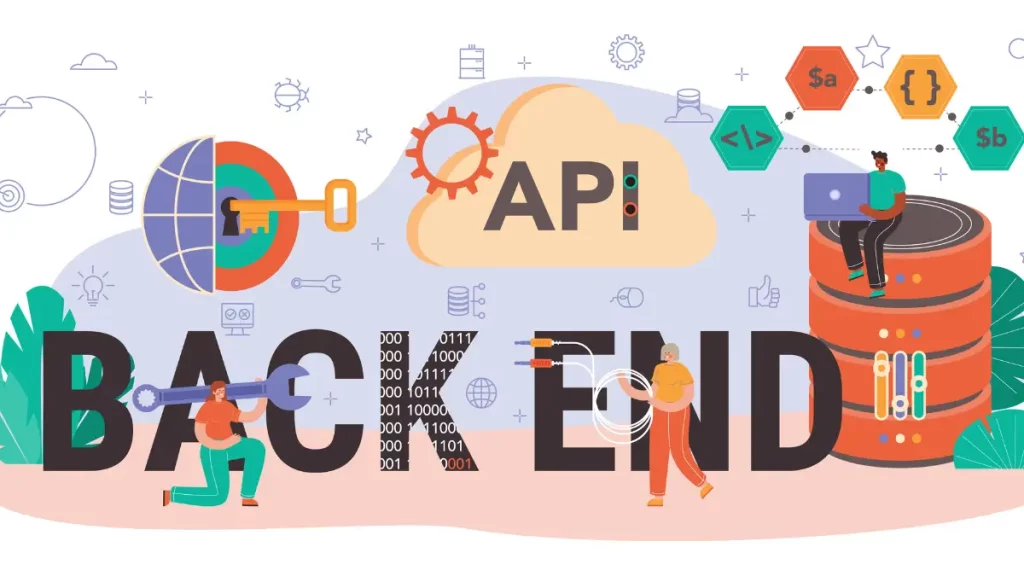Have you ever wondered how a website knows your preferences or how it securely processes your payments? The answer lies in the unseen world of back-end web development. This crucial aspect of web application development handles the server-side operations, ensuring a seamless user experience and data security.
So what is back-end web development? Building a robust and secure back-end requires a deep understanding of best practices and emerging technologies. This article will explore essential back-end development concepts and provide practical guidelines to help you achieve this.

What Is Back-End Web Development?
Back-end web development refers to the server-side aspects of web development that handle the behind-the-scenes functionality necessary to power websites and web applications. While the front-end focuses on the visible user interface and interaction (what users see and interact with), the back-end manages the logic, database interactions, server communications, and application performance to make everything work seamlessly. A professional service provider like Smartly Done ensures that these back-end processes are developed with efficiency and security in mind, delivering robust solutions that support scalable and high-performance applications.
Best Practices for Building Web Applications
With the increasing number of cyber threats, following security best practices is essential for safeguarding sensitive information and preventing vulnerabilities. Below are some of the best practices for building secure web applications that every developer should implement.
1. Use HTTPS
One fundamental step for securing web applications is to use HTTPS instead of HTTP. HTTPS (Hypertext Transfer Protocol Secure) ensures that the data transferred between the client (browser) and the server is encrypted using SSL/TLS protocols. This encryption prevents malicious actors from intercepting sensitive information, such as passwords or personal data.
Without HTTPS, attackers can exploit the unsecured connection to perform man-in-the-middle (MITM) attacks, eavesdrop on communications, or even modify the data exchanged. Therefore, it’s critical for any web application—especially those handling sensitive information like e-commerce sites or banking platforms—to implement HTTPS.
2. Input Validation
Proper input validation is essential to defend against malicious data inputs that can disrupt an application’s functioning or expose vulnerabilities. One common threat is SQL injection, where an attacker can insert malicious SQL code into user inputs, potentially gaining unauthorized access to the database or altering its contents.
Input validation ensures that data sent by the user is formatted correctly and doesn’t contain harmful code. This includes checking for the appropriate data type (e.g., providing a user ID as a number), restricting the length of inputs, and escaping special characters. By filtering out invalid or harmful data, you reduce the chances of your application being compromised by unintended input.
3. Secure Authentication and Authorization
Authentication and authorization are critical elements of web security. Authentication is about verifying a user’s identity, while authorization ensures that a user has the correct permissions to access specific resources. Using modern authentication protocols like OAuth or JWT (JSON Web Tokens) allows for secure and efficient management of user sessions.
Additionally, enforcing multi-factor authentication (MFA) can significantly strengthen the login process, making it much harder for unauthorized users to gain access. Secure password storage is also crucial. Passwords should never be stored in plain text; instead, hashing algorithms like bcrypt or Argon2 should be used, as they make it difficult to reverse-engineer passwords from hashed data.
4. Avoid Exposing Sensitive Data
Hard-coding sensitive information like API keys, database credentials, or passwords in your source code can be highly dangerous. If these credentials are exposed, either through a breach or inadvertently during a code commit, attackers can misuse them to gain unauthorized access to your systems.
Instead, sensitive data should be stored in secure environments like environment variables, configuration files, or secret management services (e.g., AWS Secrets Manager, Google Secret Manager). These solutions ensure that sensitive data is not easily accessible, even to developers, reducing the risk of leakage or unauthorized access.
5. Data Encryption
Data encryption is an essential part of securing sensitive information in web applications. Encryption transforms data into unreadable code, which can only be deciphered by someone with the correct decryption key. There are two critical aspects of encryption: data at rest and data in transit.
Data at rest refers to stored data, like database records, and should be encrypted using strong encryption algorithms such as Advanced Encryption Standard (AES). Data in transit or information being transferred over networks should be protected using SSL/TLS to prevent eavesdropping. Encrypting both at-rest and in-transit data ensures that even if an attacker gains access, the information remains protected and unusable without the proper keys.
6. Regularly Update Dependencies
Many web applications rely on third-party libraries, frameworks, or plugins, which can be vulnerable to security exploits if they are not kept up to date. Older versions of software might contain known vulnerabilities that attackers can exploit.
Therefore, it is essential to update your dependencies and check for security patches regularly. Tools like npm audit (for Node.js) and pip-audit (for Python) automatically check for known vulnerabilities in your project’s dependencies. Regular updates reduce the risk of attacks that exploit outdated software, ensuring that your application remains secure as threats evolve.

7. Use Prepared Statements
When interacting with databases, using prepared statements is a best practice to avoid SQL injection attacks. Prepared statements ensure that user inputs are treated strictly as data rather than executable code.
This means that even if an attacker tries to inject malicious SQL queries through form inputs, the database will treat the input as plain text rather than a command, preventing any harmful actions. Prepared statements, combined with parameterized queries, effectively neutralize the risk of SQL injection and protect the integrity of your database.
8. Cross-Site Scripting (XSS) Prevention
Cross-site scripting (XSS) is a common vulnerability where an attacker injects malicious scripts into a trusted web application, potentially compromising user data or even taking over user sessions. To prevent XSS, developers must ensure that user-generated content is properly sanitized before it is rendered on the web page. This can be done by escaping characters like <, >, and & in HTML, which would otherwise be interpreted as executable code.
Using secure templating engines like Jinja, Pug, or EJS can also help prevent XSS attacks by automatically escaping dangerous content. Additionally, implementing Content Security Policy (CSP) can help limit which scripts are allowed to run on your web pages, adding another layer of defence against XSS.
9. Cross-Site Request Forgery (CSRF) Protection
Cross-site request Forgery (CSRF) is an attack in which a malicious website tricks a user into making unintended requests to another site where they are authenticated, potentially performing unauthorized actions.
Web applications can use CSRF tokens, which are unique, secret values associated with each user session, to prevent CRF. These tokens are included in every state-changing request and are validated on the server to ensure that the request is legitimate. Additionally, ensuring that sensitive actions are only accessible via POST, PUT, or DELETE requests rather than GET requests can help mitigate CSRF risks.
10. Session Management
Managing user sessions securely is critical to preventing session hijacking or unauthorized access. One best practice is to use secure cookies that have the HttpOnly flag, which prevents JavaScript from accessing them, and the Secure flag, which ensures they are only transmitted over HTTPS.
Regularly expiring sessions or invalidating them after certain actions can also reduce the risk of session hijacking. Implementing short session timeouts and re-authentication for sensitive actions are additional safeguards that can further protect user data during a session.
11. Logging and Monitoring
Effective logging and monitoring can help detect and respond to potential security threats in real-time. It’s crucial to log key events, such as login attempts, failed login attempts, password changes, or suspicious activities, such as SQL injection attempts or abnormal data queries.
Tools like Elasticsearch, Logstash, Kibana (ELK), or Graylog can aggregate logs, making it easier to identify patterns or anomalies. Additionally, setting up alerts for abnormal activities can provide early warnings of a potential security breach, allowing quick responses before significant damage is done.
12. Secure APIs

In many modern web applications, APIs play a central role in facilitating communication between the client and the server. Ensuring that APIs are secure is crucial. This can be achieved by enforcing strict authentication protocols, such as OAuth or JWT, to ensure that only authorized users can interact with your APIs.
Implementing rate limiting to prevent abuse and configuring Cross-Origin Resource Sharing (CROS) policies to restrict where requests can originate further enhances API security. Additionally, APIs should always limit the data they expose by default and ensure that sensitive information is not inadvertently included in API responses.
13. Implement Least Privilege Access
The principle of least privilege access ensures that users and systems are granted the minimum level of access necessary to perform their tasks. For instance, a user should not have administrative rights unless required, and database queries should only have access to the specific data they need.
Limiting permissions in this way reduces the attack surface, as compromised accounts or systems will have minimal access to critical resources. This can be enforced through proper role-based access control (RBAC), ensuring that each user role has only the permissions necessary for its function.
14. Regular Security Audits and Penetration Testing
One of the best ways to identify vulnerabilities in your web application is through regular security audits and penetration testing. A security audit involves reviewing your application’s code, dependencies, configurations, and overall infrastructure to find any weak points.
On the other hand, penetration testing simulates an attack on your system to see how well it can withstand malicious actions. Conducting these regularly can help identify and fix potential vulnerabilities before attackers exploit them, ensuring that your application remains secure over time.
Conclusion
To conclude the query “What is back-end web development?”. We know, it is building a robust and secure back-end is essential for the success of any web application. By understanding core concepts, best practices, and emerging technologies, you can create systems that are efficient, reliable, and protect user data. Remember to prioritize security measures, optimize performance, and continuously stay updated on industry trends to ensure your back-end development aligns with the evolving demands of modern web applications.

13+ Yrs Experienced Career Counsellor & Skill Development Trainer | Educator | Digital & Content Strategist. Helping freshers and graduates make sound career choices through practical consultation. Guest faculty and Digital Marketing trainer working on building a skill development brand in Softspace Solutions. A passionate writer in core technical topics related to career growth.



